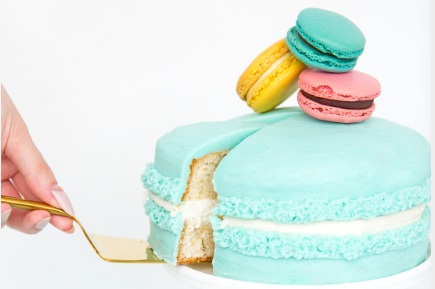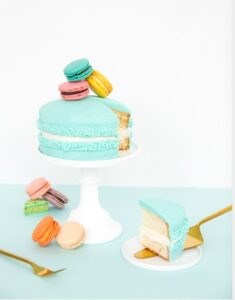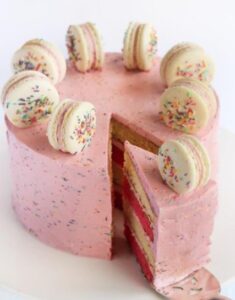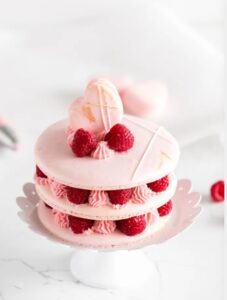Introduction to Macaron Cakes
Macaron cakes, a delightful blend of the elegant French macaron and traditional cake layers, have emerged as a culinary trendsetter in the world of desserts. These creations trace their roots to France, where chefs first crafted the macaron, a delicate meringue-based confection known for its smooth top, ruffled circumference, and rich filling. The fusion of these macarons with various cake bases has given rise to the macaron cake, a dessert that combines the crisp, chewy texture of macarons with the soft, moist layers of cake.
Popularity and Trends
The popularity of macaron cakes has soared in recent years, thanks to their visual appeal and versatility in flavor combinations. These cakes have become a favorite at weddings, parties, and high-end bakeries, celebrated for their ability to be customized in color and taste. Social media platforms, brimming with images of these aesthetically pleasing desserts, have further propelled their fame, making them a trendy choice for those seeking both taste and presentation. The macaron cake, with its blend of tradition and innovation, stands as a testament to the evolving art of pastry and continues to capture the hearts of dessert enthusiasts worldwide.
Understanding Macaron Cakes
At its core, a macaron cake is a creative combination of macarons – the delicate, meringue-based confections – and cake layers or fillings. Originating from France, macarons have a rich history and are known for their vibrant colors and intricate flavors. When these are combined with cake, the result is a dessert that is both visually stunning and deliciously satisfying.
Types of Macaron Cakes
Macaron cakes come in an array of types, each offering a unique taste and visual appeal. The classic flavors form the foundation, with variations and innovative ideas adding to the diversity.
Classic Flavors and Variations
The traditional macaron cake often features time-honored flavors like vanilla, chocolate, and strawberry. These classics provide a familiar and comforting taste, making them a perennial favorite. Bakers often enhance these flavors with rich fillings like buttercream, ganache, or fruit jams, adding depth and complexity to the cake. Variations of these classics might include the infusion of coffee in chocolate macarons or the addition of lemon zest to vanilla ones, creating a delightful twist on the familiar.
Innovative Macaron Cake Ideas
Creativity knows no bounds when it comes to macaron cakes. Some bakers experiment by incorporating unusual flavors like matcha, lavender, or salted caramel, offering a gourmet experience. Others might layer different flavored macarons in a single cake, creating a mosaic of tastes and colors. Textural innovations, such as adding crunchy elements like nuts or toffee bits, also contribute to the uniqueness of these cakes.
Seasonal and Thematic Macaron Cakes
Seasonal ingredients inspire many macaron cakes, with flavors adapting to the time of year. Autumn might bring pumpkin spice macarons, while summer could see the introduction of mango or raspberry. These seasonal varieties not only offer a fresh taste but also connect the dessert with the ambiance of the season.
Thematic macaron cakes, tailored for specific events or holidays, also enjoy great popularity. A Christmas-themed cake might feature red and green macarons with a peppermint flavor, while a Valentine’s Day cake could boast heart-shaped macarons with a rose or cherry filling. These thematic cakes not only delight the palate but also add a festive touch to any celebration.
Ingredients and Tools for Macaron Cakes
Creating a macaron cake requires a blend of specific ingredients and the right tools to bring this elegant dessert to life.
Essential Ingredients for Macaron Cakes
The foundation of any macaron cake lies in its essential ingredients. For the macarons, almond flour serves as the base, providing a nutty flavor and delicate texture. Fine granulated sugar and egg whites combine to create the meringue, giving macarons their signature crisp exterior and chewy interior. Food coloring adds a visual appeal, allowing bakers to customize the macarons to their desired hue. For the cake component, standard baking ingredients like all-purpose flour, baking powder, butter, and sugar form the base, while various flavorings and fillings enhance the overall taste.
Recommended Tools and Equipment
In terms of tools, a few key items are indispensable. A reliable mixer, either stand or hand-held, is crucial for achieving the right consistency in both the macaron batter and cake mix. Baking sheets and parchment paper provide the surface for piping and baking the macarons. Piping bags with various nozzles allow for precision in shaping the macarons and decorating the cake. An oven with accurate temperature control ensures that both macarons and cake bake evenly. Lastly, a range of spatulas and mixing bowls facilitate the mixing and handling of ingredients.
For high-quality almond flour, which is a crucial ingredient, Bob’s Red Mill offers an excellent variety.
Macaron Cake Recipes
Creating a macaron cake can range from simple to sophisticated, depending on the recipe and the baker’s skill level. Here, we explore a basic macaron cake recipe and a more advanced option for those seeking a challenge.
Basic Macaron Cake Recipe
Ingredients:
- Macarons: Almond flour, granulated sugar, egg whites, food coloring
- Cake: All-purpose flour, sugar, butter, eggs, baking powder, milk, vanilla extract
Steps:
- Prepare Macarons: Start by making the macaron shells. Whip egg whites and sugar to form a glossy meringue. Gently fold in almond flour and add food coloring as desired. Pipe small circles onto a baking sheet lined with parchment paper and let them rest before baking until they form a skin.
- Bake Macarons: Bake the macarons in a preheated oven until they rise and develop their characteristic ‘feet’. Allow them to cool completely.
- Make Cake Batter: Cream butter and sugar, then add eggs and vanilla. Mix in the dry ingredients alternately with milk.
- Bake Cake Layers: Divide the batter into prepared pans and bake until a toothpick inserted comes out clean. Let the cakes cool.
- Assemble: Once cooled, layer the cakes with buttercream and macarons, alternating between the two. Finish with a layer of macarons on top for decoration.
Advanced Recipe: Neapolitan Macaron Delight Cake
Ingredients:
- Chocolate, strawberry, and vanilla macarons
- Chocolate, strawberry, and vanilla cake layers
- Chocolate ganache, strawberry, and vanilla buttercream
Steps:
- Prepare Macarons: Make three batches of macarons, one each for chocolate, strawberry, and vanilla flavors. Use appropriate flavorings and colors.
- Bake Macarons: Bake each batch separately and let them cool.
- Prepare Cake Layers: Bake three separate cake layers, each flavored as chocolate, strawberry, and vanilla.
- Make Ganache and Buttercream: Prepare chocolate ganache and strawberry and vanilla buttercream.
- Assemble the Cake: Start with a cake layer, spread ganache, then a layer of buttercream, and top with a layer of corresponding flavored macarons. Repeat for each flavor layer.
- Decorate: Use the remaining macarons and buttercream to decorate the top and sides of the cake.
Tips for Perfect Macarons
- Consistent Baking: Ensure your oven temperature is accurate for even baking.
- Meringue Texture: Whip the egg whites and sugar to stiff peaks for a glossy and firm meringue.
- Resting Time: Allow piped macarons to rest until they form a skin; this prevents cracking.
- Gentle Folding: Fold the almond flour into the meringue gently to avoid deflating the mixture.
- Piping Technique: Practice a consistent piping technique for uniform macarons.
Decorating Macaron Cakes
Decorating macaron cakes is an art that allows bakers to express their creativity and add a personal touch to their creations. From choosing color schemes to arranging macarons, the possibilities are endless.
Creative Decoration Ideas
Color Coordination: Select macarons in colors that complement the cake’s flavor and the occasion. For instance, pastel shades work well for spring events, while bold colors suit festive celebrations.
Edible Embellishments: Enhance the cake’s appearance with edible decorations like gold leaf, edible flowers, or sprinkles. These elements add texture and a luxurious feel.
Themed Decorations: For themed events, tailor the cake’s decoration to match. Use shaped macarons, themed toppers, or specific color palettes to align with the theme.
Techniques for Assembling and Decorating
Layering Macarons: Arrange macarons around the edge of each cake layer for a sophisticated look. This technique not only adds elegance but also gives a sneak peek of what’s inside.
Topper Arrangement: Place macarons on the top of the cake in a deliberate pattern. A circular arrangement or a cascading design can create a visually striking effect.
Buttercream Piping: Use buttercream piping to add intricate details. Swirls, rosettes, or simple dots can complement the macarons and add to the cake’s overall aesthetic.
Adding Personal Touches
Custom Messages: Incorporate custom messages using piped lettering or letter-shaped macarons. This personalization makes the cake more meaningful for the recipient.
Flavor and Color Matching: Match the macaron flavors and colors with the cake’s theme or the recipient’s preferences. This thoughtful consideration shows attention to detail.
Handcrafted Elements: Add handcrafted sugar flowers or fondant figures for a unique touch. These elements can reflect the baker’s skill and add a bespoke quality to the cake.
Serving and Storage
Serving and storing macaron cakes properly ensures they remain as delightful to taste as they are to behold.
Best Practices for Serving
Room Temperature Serving: Serve macaron cakes at room temperature. This practice enhances the flavors and textures, especially the buttery softness of the cake and the chewy crispness of the macarons.
Pre-Slicing: For ease of serving, pre-slice the cake before presenting it. Use a sharp, clean knife, wiping it between slices to ensure clean cuts that showcase the cake’s layers.
Pairing with Beverages: Enhance the tasting experience by pairing the cake with suitable beverages. Light teas or coffee complement the sweetness and flavors of macaron cakes well.
Storage Tips for Freshness
Airtight Containers: Store macaron cakes in airtight containers. This method prevents air exposure, which can dry out the cake and alter the texture of the macarons.
Refrigeration: If not consuming immediately, refrigerate the cake. The cool environment helps maintain the integrity of the buttercream and fillings, especially in warmer climates.
Avoiding Flavor Absorption: Keep the cake away from strong-smelling foods in the refrigerator to prevent flavor absorption.
Bringing to Room Temperature: Before serving, bring the cake back to room temperature. This step ensures the cake and macarons return to their optimal texture and flavor.
Common Challenges and Solutions in Making Macaron Cakes
Creating macaron cakes can present certain challenges, but with the right techniques, these can be easily overcome.
Troubleshooting Common Issues
Cracked Macarons: If macarons crack during baking, it often indicates that the batter was undermixed or the oven temperature too high. Ensure thorough mixing to the right consistency and use an oven thermometer to check for accurate temperatures.
Uneven Cake Layers: For layers that bake unevenly, check the oven for hot spots and rotate the pans halfway through baking. Also, ensure the batter is evenly distributed in the pans before baking.
Buttercream Too Runny or Stiff: If buttercream is too runny, it might need more powdered sugar or a bit more chilling. If too stiff, gently warm it up and whip again. The key is to achieve a spreadable, stable consistency.
Expert Tips for Success
Resting Macarons: Allow piped macarons to rest until they form a skin. This step is crucial for developing their characteristic smooth tops and ruffled feet.
Room Temperature Ingredients: Use room temperature ingredients, especially eggs and butter, for a more consistent batter and buttercream.
Gentle Folding: When combining ingredients, especially for macarons, fold gently to retain air in the batter.
Test Bake: Conduct a test bake of a few macarons before baking the entire batch. This approach allows you to adjust the oven temperature or batter consistency as needed.
FAQs About Macaron Cakes
Q: Can I make macaron cakes in advance? A: Yes, you can prepare macaron cakes in advance. Bake the macarons and cake layers a day or two before and store them separately. Assemble and decorate the cake on the day of serving for the best freshness and presentation.
Q: How long do macaron cakes last? A: Macaron cakes typically last up to three days when stored in an airtight container in the refrigerator. However, for optimal taste and texture, it’s best to consume them within 24 hours of assembly.
Q: Are macaron cakes suitable for people with gluten allergies? A: Yes, macaron cakes can be suitable for those with gluten allergies, as traditional macarons use almond flour instead of wheat flour. Ensure that all other ingredients, including the cake layers, are gluten-free.
Q: Can I freeze macaron cakes? A: Freezing is not recommended for fully assembled macaron cakes, as it can affect the texture of the macarons and the cake. However, you can freeze the individual components – macarons and cake layers – and assemble them after thawing.
Q: What’s the best way to transport a macaron cake? A: Transport the cake in a sturdy box that accommodates its size without squishing the decorations. Keep the cake level and avoid sudden movements or temperature changes during transport.
Conclusion of Macaron Cakes
Macaron cakes are a delightful blend of tradition and innovation, offering a unique experience for both the baker and the consumer. With the right ingredients, tools, and a bit of creativity, anyone can dive into the world of these exquisite desserts. For those looking to explore more about premium cocoa powders for their baking needs, Cacao Barry is an excellent resource.




